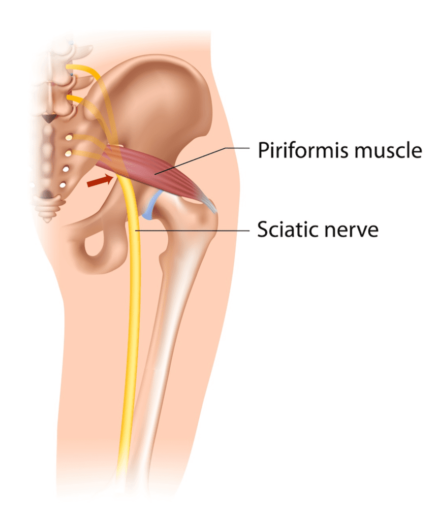Introduction: Piriformis syndrome is a painful and often misunderstood condition that affects many individuals, causing discomfort, reduced mobility, and frustration. The piriformis muscle, a small but crucial muscle located deep in the buttocks, plays a pivotal role in our body’s ability to move and maintain proper posture. When this muscle becomes irritated or inflamed, it can lead to a set of symptoms collectively known as piriformis syndrome symptoms.
In this article, we will delve into the world of piriformis syndrome, exploring its symptoms, potential causes, diagnosis, and management options. Understanding these aspects is essential for those who might be suffering from this condition or anyone looking to prevent it.
Symptoms of Piriformis Syndrome
- Buttock Pain: One of the hallmark symptoms of piriformis syndrome is persistent pain in the buttocks, often described as a dull ache or burning sensation. This pain can be localized or radiate down the back of the leg, following the path of the sciatic nerve.
- Sciatica: Sciatica is another common symptom of piriformis syndrome. It occurs when the inflamed piriformis muscle compresses or irritates the sciatic nerve, which leads to sharp, shooting pain down the leg, often extending to the calf or even the foot.
- Tingling and Numbness: Individuals with piriformis syndrome may experience tingling or numbness in the buttocks, thighs, or legs. This sensation is often linked to nerve compression.
- Muscle Weakness: Muscle weakness can result from prolonged irritation of the piriformis muscle and the surrounding area. Weakness in the hip and leg muscles can affect one’s ability to walk, stand, or perform physical activities.
- Increased Pain in Sitting or After Sitting: Sitting for extended periods can exacerbate piriformis syndrome symptoms. Many people find that the pain intensifies during or after sitting for prolonged durations.
- Difficulty in Walking: Some individuals with piriformis syndrome may experience difficulty in walking or a noticeable limp due to the discomfort and pain associated with the condition.
- Pain with Certain Movements: Symptoms can also be triggered or worsened by specific movements, such as climbing stairs, running, or prolonged periods of standing.
Potential Causes of Piriformis Syndrome
While the exact causes of piriformis syndrome are not always clear-cut, several factors can contribute to its development:
- Piriformis Muscle Tightness: Tightening or spasms of the piriformis muscle can lead to compression of the sciatic nerve.
- Injury or Trauma: A fall, accident, or direct trauma to the buttocks can damage the piriformis muscle and lead to its inflammation.
- Overuse or Repetitive Movements: Certain occupations or activities that involve repetitive motions or sitting for extended periods can strain the piriformis muscle and lead to irritation.
- Anatomical Variation: Some individuals may have an anatomical variation where the sciatic nerve passes through or under the piriformis muscle, making them more susceptible to the syndrome.
Diagnosis and Management
Diagnosing piriformis syndrome can be challenging, as its symptoms can mimic. Those of other conditions like herniated discs or lumbar radiculopathy. To properly diagnose the condition, a healthcare provider may use a combination of the following:
- Clinical Evaluation: Your healthcare provider will conduct a thorough physical examination to assess your range of motion. Muscle strength, and tenderness.
- Imaging Studies: In some cases, X-rays, MRIs, or CT scans may be used to rule out other potential causes of pain and to confirm the diagnosis.
Once diagnosed, the management of piriformis syndrome usually involves a combination of conservative treatments, such as:
- Physical Therapy: Physical therapy can help alleviate symptoms by addressing muscle imbalances, increasing flexibility, and improving posture.
- Medications: Pain relievers, muscle relaxants, or anti-inflammatory medications may be prescribe to manage discomfort.
- Heat and Ice Therapy: Applying heat or ice to the affected area can help reduce inflammation and alleviate pain.
- Stretching and Strengthening Exercises: Specific exercises can be beneficial in relieving symptoms and preventing recurrences.
- Ergonomic Adjustments: For those whose condition is aggravate by sitting, ergonomic adjustments can provide relief.
- Injections: In some cases, corticosteroid injections into the piriformis muscle can provide short-term relief.
In more severe cases, or when conservative treatments do not provide adequate relief. Surgical intervention may be consider to release the piriformis muscle and alleviate pressure on the sciatic nerve.
Conclusion
Piriformis syndrome is a condition that can significantly impact an individual’s quality of life. Leading to pain, numbness, and reduced mobility. Understanding the symptoms, potential causes, and treatment options is essential for those who may be dealing with this condition. Early diagnosis and appropriate management can help individuals regain their comfort and freedom of movement. If you suspect you have piriformis syndrome, consult a healthcare provider to start your journey towards relief and recovery.

